What kind of pedestals are those? You can use those fridge pedestal without wheels for washing machine too. The trolley with wheels cause lot of problems like the machine wandering off the spot if there is slope on the floor and dancing if there is imbalance in load. I got that fridge pedestal for about 100 rupees from a local shop. It hasn't cracked yet in the six months I'm using it.
Front loading or top loading washing machine?
- Thread starter DrkLord
- Start date
You are using an out of date browser. It may not display this or other websites correctly.
You should upgrade or use an alternative browser.
You should upgrade or use an alternative browser.
Kaleen Bhaiya
Innovator
3500. WM-03How much is this and which model ?
No observable diff as such.you notice a difference in wash quality with the hard water compared to your previous location presumably softer water?
Didn't stain my clothes. Yes, it's 40C.Any difference in stain removal? presuming you wash in a minimum 40-degree water
Not much. Quite the contrary, increasing the quantity leads to sudsing. I am still trying to figure what is the right quantity for my regular load. The sudsing isn't visible during wash cycle, but it becomes apparent during rinse cycle. It has something called Aqua detergent which I read throws water out but retains detergent to get the maximum from the detergent. Even the drain water despite 3 rinses, machine still has some sudsing left baffles me.How much have you had to increase your usual detergent dose?
As a last step, I am forced to run a rinse cycle so that the machine and the drum is rid of the residue.
Already did that. It's mentioned in my LG FL thread. Even attached sticky rubber pads which LG provides to attach to the machine's leg if placed in bathroom. So that the machine won't lose on the grip. Yet, it moved. Maybe it depends on power transfer. Gradual versus smooth.you definitely need to get a spirit level. Clearly hand levelling was not sufficient.
Last edited:
blr_p
Quasar
Scale Defence3500. WM-03
How it works
Works in keeping pipes scale-free
Doesn't list the model number but a further search found the same product selling abroad with more info about its working.
Scale Defence- Washing Machine and Dishwasher (K-WM03)
Scale Defence- Washing Machine and Dishwasher (K-WM03) Impulse Frequency Mineral Descaler
Priced at $150 so paying Rs.3500 seems like a steal
They link to a case study which explains the problems of both hard and soft water for water heaters and why it's necessary to deal with it but makes no mention of their product to do so (!)
Why do minerals scale bonds change back into their original shape after 1-7 days?
Wobbling impulse frequencies cause minerals to change from spiky sphere-shaped structures into smooth rod-shaped crystals due to the energy transmitted in the frequency impulses. This molecular mineral energy has a lifespan from initial contact. The warmer the water passing through the impulse frequency coils the stronger the reaction. There is more inherent energy in hot water than cold water and this is why bonds keep their smooth rod-shaped appearance up to, and after, 7 days in hot water.
Why do bonds only hold together for 1-2 days in cold water and up to 7 days in hot water?
There is more inherent energy in hot water than cold water and this is why bonds keep their smooth rod-shaped appearance up to, and after, 7 days in hot water.
That is what they claim their product does to water. If the water is hot apparently its ability not to scale lasts 7 days but if its cold then two days. This only matters if you store the water. If its flowing through a pipe or used in any appliance then this info is not necessary.
Lots of references in the below link
Dubious water treatment schemes (just amazing how many different junk products you find here
 )
)Magnetic water treatment and pseudo science
People still believe they work and the reasons are in the next one.
Non Chemical Devices: Thirty Years of Myth Busting (pdf)
1. Device operation causes calcium carbonate to precipitate as aragonite, not calcite, generally as a bulk precipitation; also causes any existing calcite in the system to re-crystallize to aragonite.
To date, all controlled studies of devices claiming this ability have shown that the calcium carbonate continues to crystallize as calcite, not aragonite.
We would note that this ability is claimed (or inferred) by many of the NCD suppliers for their devices with claims such as, ‘scale forming minerals change their ionic construction,’ or, ‘dissolved solids precipitate as a loose, powdery dust.’ While it all sounds scientific, aragonite will form in place of calcite only under well-defined temperature and pressure conditions. Note should be made that the primary factor in dictating the crystal structure adopted is geometry of the ions; i.e., their size.
Exposure to electrical and/or magnetic fields has never been shown to affect the size of ions in solution. In addition, aragonite forms scales that are as hard and tough as calcite, so there would appear to be no good reason for preference of one crystal structure over the other
3. NCD operation alters the behavior of molecules or particles in the water by aligning their polarities to neutralize the adhesion required to form scale.
Not considering any effects within the device, any such polarity alignment would be immediately destroyed in the operating water system by simple Brownian motion.
Those are the two claims this company makes. I'm sceptical as to how well it works. But there is a way to test
He pours the untreated water and treated water into two saucers. Let them sit out to dry and then tries to wipe off the residue at the bottom.
He finds it easier to wipe off the residue from the treated vs the untreated. This means any scale that forms will be weaker than otherwise and in theory, be easier to remove
In the dishwasher, the glass cleaned better with treated water and no hard water stains compared to untreated.
Cost? $400

Last edited:
blr_p
Quasar
Another testimonial. Cleaner glass. Something I notice with American dishwashers. They do not have a built-in water softening system like you get in Europe or here. So hard water stains are more of a headache in the US. They do not add salt to their dishwashers.
Water flows through a shower head so there isn't much time for the scale to form. Granted it gets more volume of water flowing through it like a tap.
What happens when the water is trapped in an appliance for 2h30? Not as bad as a water heater which holds the water for much longer and is hot as well.
The wash cycle will be close to 2h so whatever scale there is in the water will deposit. Then there are the shorter rinse cycles.
A kettle gives an indication but its quite short and its contact time that determines how much scale gets deposited or not.
Does that mean less scale in a washing machine?
We will use a traditional way to determine this. YOUR EYES !!
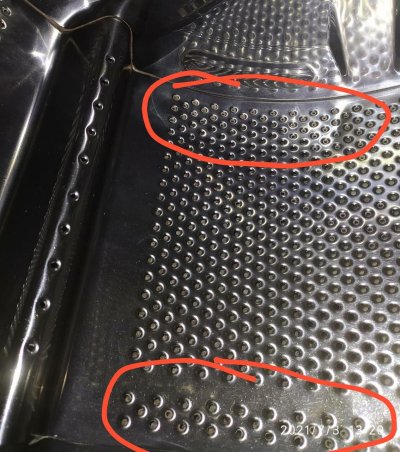
Every month, shine a torch and take a close look. You don't want to see any scale residue poking through the holes. If you do like in this pic which probably has not had a descale in months if much longer then you need to descale until you cannot see any residue AT ALL.
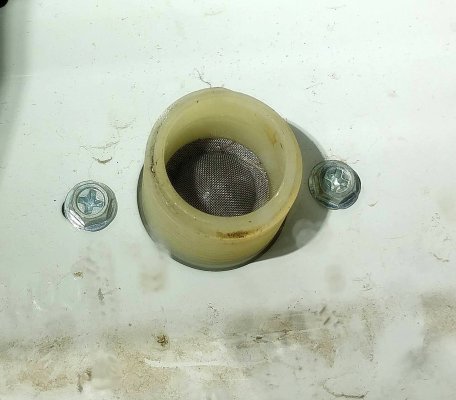
Also, keep an eye on the inlet valve. EVERY MONTH. How clear is it?
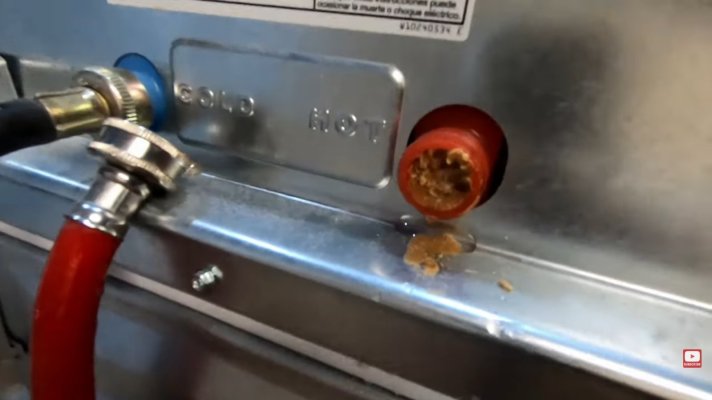
It should not look like ^that. if it does then this electronic descaler thing ain't working
The YouTuber who i got that pic from had a water hardness of around 250ppm btw !!! He returned his unit and got a polyphosphate filter for his tankless water heater. This considerably reduced the scaling on the inlet. But he said he still gets a little scale buildup so the max hardness such a filter can handle is 250 ppm. People with well water of 500 ppm or more said this filter did not do much for them.
Water flows through a shower head so there isn't much time for the scale to form. Granted it gets more volume of water flowing through it like a tap.
What happens when the water is trapped in an appliance for 2h30? Not as bad as a water heater which holds the water for much longer and is hot as well.
The wash cycle will be close to 2h so whatever scale there is in the water will deposit. Then there are the shorter rinse cycles.
A kettle gives an indication but its quite short and its contact time that determines how much scale gets deposited or not.
Does that mean less scale in a washing machine?

We will use a traditional way to determine this. YOUR EYES !!

Every month, shine a torch and take a close look. You don't want to see any scale residue poking through the holes. If you do like in this pic which probably has not had a descale in months if much longer then you need to descale until you cannot see any residue AT ALL.

Also, keep an eye on the inlet valve. EVERY MONTH. How clear is it?

It should not look like ^that. if it does then this electronic descaler thing ain't working
The YouTuber who i got that pic from had a water hardness of around 250ppm btw !!! He returned his unit and got a polyphosphate filter for his tankless water heater. This considerably reduced the scaling on the inlet. But he said he still gets a little scale buildup so the max hardness such a filter can handle is 250 ppm. People with well water of 500 ppm or more said this filter did not do much for them.
Last edited:
blr_p
Quasar
No stiffness in the clothes?No observable diff as such.
Hard water is harder to wash with but should be easier to rinse the detergent out than soft water. So you will see more suds with soft water than with hard water. I'm surprised with the hardness you have that you see much suds at allNot much. Quite the contrary, increasing the quantity leads to sudsing. I am still trying to figure what is the right quantity for my regular load. The sudsing isn't visible during wash cycle, but it becomes apparent during rinse cycle. Even the drain water despite 3 rinses, machine still has some sudsing left baffles me. As a last step, I am forced to run a rinse cycle so that the machine and the drum is rid of the residue.
Amount of detergent I've said to start with half a scoop for a full load. Don't go less than that or the clothes will not be cleaned properly.
How full are your loads? a smaller load could foam up more with that amount of detergent than a full load. If you overload then detergent won't be able to mix properly.
Thicker items like towels are going to suds more than thinner fabrics with any detergent.
If suds are too much then maybe the detergent isn't dissolving properly.
Is that because the water temperature is too low that residue is being left or the water is too hard? you tell me
You can try mixing it in some warm water (not hot) and then pouring it into the detergent drawer. This will decide if the problem is of dissolving or not.
A second way is to add the detergent directly into the drum instead of the drawer and then add the clothes.
Report back on what difference either method makes.
If it still suds in the third rinse with both these methods then try Surf for front loader powder. Change the detergent.
Henko may not be suitable for your water conditions. I can't remember if Henko just suds up more than other detergents. Meaning they cheaped out on anti-foaming agents.
What you're referring to is this Ball valve tech. What does it do? Ball valve allows interrupting the cycle to add extra laundry. Hence, lets the water out while keeping the detergent in. Confusing until you realise 'add item' is the only use case when you want to drain the water out but not the detergent.It has something called Aqua detergent which I read throws water out but retains detergent to get the maximum from the detergent.
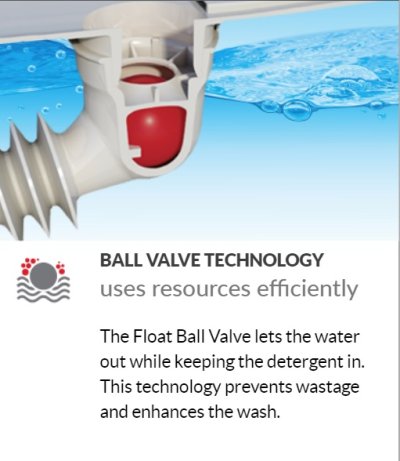
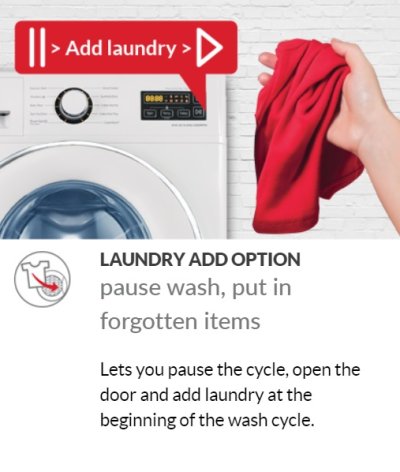
The device lets you pause the cycle, open the door and add laundry during the wash cycle. This technology prevents wastage and enhances the wash. So any machine that has the 'add item' feature has similar tech like this. A machine without the 'add item' feature like my LG does not have it.
This has nothing to do with leaving foam behind as you think. The machine is not responsible for the excess suds.
You said it only happened when you washed one item and the problem went away after you got the service guy to look at it.Already did that. It's mentioned in my LG FL thread. Even attached sticky rubber pads which LG provides to attach to the machine's leg if placed in bathroom. So that the machine won't lose on the grip. Yet, it moved. Maybe it depends on power transfer. Gradual versus smooth.
Maybe your machine has since moved and needs another levelling
Kaleen Bhaiya
Innovator
Nope.No stiffness in the clothes?
I am equally baffled with this result. It shows little sudsing during wash cycle. But during 1st and later rinse cycle, the sudsing becomes apparently visible but nothing alarming. Offcourse, it subsides with every rinse cycle.I'm surprised with the hardness you have that you see much suds at all
Don't know what is going on. I wash at 40C. To add to it, water is pretty hot. And with summers soaring, the water temps are going to easily cross 40C without heating given that the regular summer temps easily crosses 46-47C at my place. Good for machine and energy saving though.
Mine ain't full load. We have already discussed keeping 5 fingers empty space from the top or 70% tub capacity. I am afraid adding more detergent than what I am adding will only lead to more sudsing. I have accepted that a little bit sudsing is acceptable. My clothes aren't that dirty except for the sweat. I can't measure it as I have that big 60gms scoop. So I use that to add small quantities of the detergent. I don't even know if that accounts for even 30gms.Amount of detergent I've said to start with half a scoop for a full load. Don't go less than that or the clothes will not be cleaned properly.
Not the case. As mentioned, the suds becomes more visible only during rinse cycle. It's very little during the wash cycle. But definitely not alarming. There have been situations where I have added excess detergent relative to the load so I always keep a tab on the load: detergent quantity. Not too much detergent to cause excessive foaming.If suds are too much then maybe the detergent isn't dissolving properly.
You mean residue on the clothes? Not that I can see. But I am confident that there won't be due to my cautious approach on how much detergent I add.Is that because the water temperature is too low that residue is being left or the water is too hard?
How does the detergent mix with the water if I add directly into the drum. Quite the contrary, detergent might stick to the clothes as the drum starts rotating before it is completely filled with water. If I add to the dispenser, it should go all the way to the bottom of the drum, mix with water and then come in contact with the clothes.A second way is to add the detergent directly into the drum instead of the drawer and then add the clothes.
I must have confused this with Aqua Energie as mentioned on my machine. Don't know if both do the same function.What you're referring to is this Ball valve tech.
blr_p
Quasar
Maybe it will come later. There will be mineral residue buildup in the clothes over time. Give it a few months and see how it goes. I've heard people complain of this with towels.Nope.
Dissolving should work fine then. Henko might just be a more sudsing detergent compared to others. Unless you try others we don't know.I am equally baffled with this result. It shows little sudsing during wash cycle. But during 1st and later rinse cycle, the sudsing becomes apparently visible but nothing alarming. Offcourse, it subsides with every rinse cycle.
Don't know what is going on. I wash at 40C. To add to it, water is pretty hot. And with summers soaring, the water temps are going to easily cross 40C without heating given that the regular summer temps easily crosses 46-47C at my place. Good for machine and energy saving though.
Have you used Henko before with softer water? Did it tend to suds longer than others?
These scoops are purposely designed to make you use the most detergent and not graduated at all. If you don't know how much you're adding then it can go either way. It's harder to adjust up or down.Mine ain't full load. We have already discussed keeping 5 fingers empty space from the top or 70% tub capacity. I am afraid adding more detergent than what I am adding will only lead to more sudsing. I have accepted that a little bit sudsing is acceptable. My clothes aren't that dirty except for the sweat. I can't measure it as I have that big 60gms scoop. So I use that to add small quantities of the detergent. I don't even know if that accounts for even 30gms.
Get some kitchen measuring spoons, preferably ones that indicate how much weight on the spoon so you know how much to add.
I was attributing the suds to undissolved detergent. I don't see how the suds form otherwise. It would seem the detergent is harder to rinse out of the clothes which surprises me considering even your rinses will be warm as well.You mean residue on the clothes? Not that I can see. But I am confident that there won't be due to my cautious approach on how much detergent I add.
It will dissolve when the drum fills and then be used for the clothes. This will bypass that Aqua Energie thing which is supposed to dissolve detergent better.How does the detergent mix with the water if I add directly into the drum. Quite the contrary, detergent might stick to the clothes as the drum starts rotating before it is completely filled with water. If I add to the dispenser, it should go all the way to the bottom of the drum, mix with water and then come in contact with the clothes.
I use the detergent paste I got like that and tabs are meant to be used in the same way as well. So no harm. Try different ways and see if you notice a difference.
Aqua energy just helps detergent dissolve better.I must have confused this with Aqua Energie as mentioned on my machine. Don't know if both do the same function.
blr_p
Quasar
Midway into April how about a hardness test?I have given my test kit to a friend to determine his water hardness. Besides, we have got rainfall this week, so I don't think water hardness would have increased. Next month should be fine and will definitely do it if I get the time.
Kaleen Bhaiya
Innovator
blr_p
Quasar
You need to keep a tab on hardness as this year wears on to understand what you are dealing with. You will need to further tests a month after the monsoons begin to see if that water gets softer or not. I don't expect it to if it's 'borewell' water.Will see if time permits. Besides, the kit is not with me anymore.
Checked the water inlet of the machine recently? any buildup with that gadget you got
Why not try a month without it attached and see if there is a difference?
nRiTeCh
Oracle
@blr_p It will be 6 months now and I haven't yet done drum clean-up job. It was advised after 30 usages or 6 months whichever earlier and obviously the machine got used more than 60 times!LG has recommended their own scalgo descaling powder for drum cleanup after 30 usages. I know its their marketing gimmick pushing customer to buy their own stuff and said other powders arent recommended bla bla and might damage the drum. The demo guy was offering 3 packets for 650.
Any good cheaper alternative brand for drum cleansing powder?
Which drum cleaning powder to use? LG does has their own.
So have used the LG FL for a month now. We are probably running it 3-4 times a week (every alternate day). I think till now I have done only one full load where it was 13-14 big size clothes, one bag of small size clothes and then one double cot bed spread. Set at cotton, 60 degrees and 800 rpm and the AI showed a time of 1:20. Pretty much every cycle is anywhere between 1:10 to 1:15 till date. Its always at 40 degrees and 400 rpm. Once a week its 60. 800 rpm I use when climate is not hot and I need clothes to dry.
The machine has not moved from its installation spot till date. Its pretty quiet but I have not noticed much given that we are busy with other chores when machine is running. I have been testing the amount of detergent to add (using Surf Excel FL). I think my scoop is a 60gm one and I use half a scoop most times. Mostly I dont notice any foam being generated. But sometimes I have noticed foam during the rinse cycle and there were a few times when foam was there near the door even after the entire cycle was completed. I have been diligently wiping the rubber gasket with a microfiber cloth. There is water droplets in the gasket grove which I try to put my fingers inside and wipe off.
Noticed that the clothes are pretty wrinkled as against a TL. Home clothes is fine but otherwise definitely need to iron them.
@blr_p Do you think its time for a descaling session? Should I just buy citric acid and run? Or buy descaling powder?
The machine has not moved from its installation spot till date. Its pretty quiet but I have not noticed much given that we are busy with other chores when machine is running. I have been testing the amount of detergent to add (using Surf Excel FL). I think my scoop is a 60gm one and I use half a scoop most times. Mostly I dont notice any foam being generated. But sometimes I have noticed foam during the rinse cycle and there were a few times when foam was there near the door even after the entire cycle was completed. I have been diligently wiping the rubber gasket with a microfiber cloth. There is water droplets in the gasket grove which I try to put my fingers inside and wipe off.
Noticed that the clothes are pretty wrinkled as against a TL. Home clothes is fine but otherwise definitely need to iron them.
@blr_p Do you think its time for a descaling session? Should I just buy citric acid and run? Or buy descaling powder?
blr_p
Quasar
That's good news then, it completes the wash in half the time it takes for mine at a full load. I was expecting it would take even longer but maybe that is not happening as your wash load does not exceed 3 kg.So have used the LG FL for a month now. We are probably running it 3-4 times a week (every alternate day). I think till now I have done only one full load where it was 13-14 big size clothes, one bag of small size clothes and then one double cot bed spread. Set at cotton, 60 degrees and 800 rpm and the AI showed a time of 1:20. Pretty much every cycle is anywhere between 1:10 to 1:15 till date. Its always at 40 degrees and 400 rpm. Once a week its 60. 800 rpm I use when climate is not hot and I need clothes to dry.
Would you recommend this machine to others? it seems a little better than the base model if one does not mind the dark grey colour. I'd have preferred it in white.
I notice the clothes are a little stiff when line dried if spun at 400 rpm but that will reduce wrinkles. At 800rpm the clothes are less so. Still have to give them a good snap and they are soft after.The machine has not moved from its installation spot till date. Its pretty quiet but I have not noticed much given that we are busy with other chores when machine is running. I have been testing the amount of detergent to add (using Surf Excel FL). I think my scoop is a 60gm one and I use half a scoop most times. Mostly I dont notice any foam being generated. But sometimes I have noticed foam during the rinse cycle and there were a few times when foam was there near the door even after the entire cycle was completed. I have been diligently wiping the rubber gasket with a microfiber cloth. There is water droplets in the gasket grove which I try to put my fingers inside and wipe off.
Noticed that the clothes are pretty wrinkled as against a TL. Home clothes is fine but otherwise definitely need to iron them.
Have you looked at clothes steamers? this one comes with two water tanks (100ml & 200ml) latter can do longer jobs
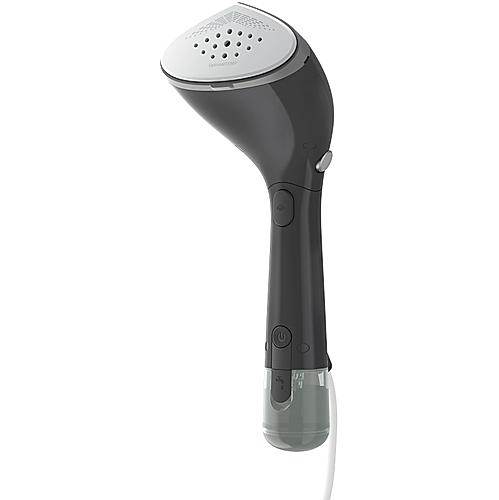
Buy Philips Handheld Garment Steamer STH7040/80 Online at Philips Dome
Shop Philips Handheld Steamer STH7040/80 Online at Philips Domestic Appliance.Philips STH7040/80 and Handheld Steam Iron are safe on all ironable fabrics and
Demo
They seem to be faster than irons especially with thinner fabric if not exactly replacing them.
Last edited:
nRiTeCh
Oracle
So after 6 months for the first time I performed drum descaling on my LG TL using Samsungs Afresh descaling powder.
Machine took 1hr45min (std time) and the end result: No dirty/silt/greasy type water got drained out but only clear water.
No odor or any bad smell after cleaning but it smells as if its a brand new machine and it was her first washing job!
Machine took 1hr45min (std time) and the end result: No dirty/silt/greasy type water got drained out but only clear water.
No odor or any bad smell after cleaning but it smells as if its a brand new machine and it was her first washing job!
Last edited:
Anyone knows what OEM company Voltas Beko imports from? Their website says country of origin is Turkey for their front load washing machine.

There's a Voltas Beko showroom near me but I doubt they know such things.
Edit: Google helped.
Arçelik A.Ş. is a Turkish multinational household appliances manufacturer which owns Beko and Grundig.
Edit2: Will a FL work on very low water pressure? Don't want to spend extra on booster pumps which just becomes another point of failure in the long run.
also remembered i have about 5Kg's of Tide Jasmine & something scented detergent left. If i buy a FL, can i use that detergent?
@blr_p ANy thoughts on this - 8.5kg fl @ 20k
There's a Voltas Beko showroom near me but I doubt they know such things.
Edit: Google helped.
Arçelik A.Ş. is a Turkish multinational household appliances manufacturer which owns Beko and Grundig.
Edit2: Will a FL work on very low water pressure? Don't want to spend extra on booster pumps which just becomes another point of failure in the long run.
also remembered i have about 5Kg's of Tide Jasmine & something scented detergent left. If i buy a FL, can i use that detergent?
@blr_p ANy thoughts on this - 8.5kg fl @ 20k
Last edited:
blr_p
Quasar
Beko is the OEM. Voltas is in a JV with themAnyone knows what OEM company Voltas Beko imports from? Their website says country of origin is Turkey for their front load washing machine.
Edit: Google helped.
Arçelik A.Ş. is a Turkish multinational household appliances manufacturer which owns Beko and Grundig.
Beko's have sealed tubs like Bosch. Bearings go? Spider goes? replace the machine. Avoid (!)
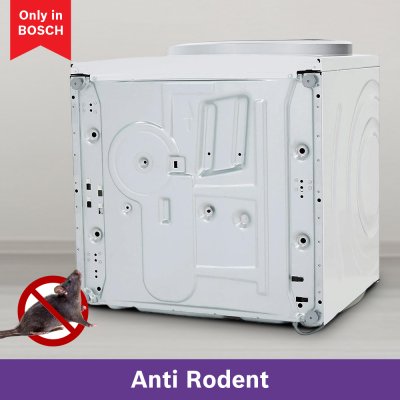
What an excellent rat guard Bosch has? I also can't help thinking how nicely they hide the fact the tub is sealed. Ain't no easy way you can just look underneath to check

Any machine that is rat guard like that has sealed tubs !!
Ask @technofast what he thinks about sealed tubs after his Bosch died within 5 years and simple bearings change is half the purchase cost when it should be no more than 5k or even lower.
There's an enthusiast i follow who is big into Beko, probably a Turk, one day I decided to point this out to him. Oh, he says but bearings are high-quality ABB. I then replied once the bearing seals fail, does not matter how good the bearing are

Now you know why the cost is so low. This is buy and throw. I will never recommend this Euro crap to anyone
How high is your tank from where the machine will beEdit2: Will a FL work on very low water pressure? Don't want to spend extra on booster pumps which just becomes another point of failure in the long run.
also remembered i have about 5Kg's of Tide Jasmine & something scented detergent left. If i buy a FL, can i use that detergent?
Any chance of installing a solar water heater?
Does it have a sealed tub? if you are able to look underneath and take a photo@blr_p ANy thoughts on this - 8.5kg fl @ 20k
For such a low price I strongly suspect it does. You know my answer then.
No touch panel just plain simple buttons will be more durable than the standard touch panels on better brands. But this does not cancel out the sealed tub.
Dimensions are reversed. The width is not 44cm but 59 cm and it is rather the depth that is 44 cm. You don't want to discover this after you buy it

Such a small dinky machine is another bloody fail in my books.
Unless you move the machine indoors you cannot fit a front loader in your balcony
Last edited:
Kaleen Bhaiya
Innovator
@6pack if you are opting for a TL, then I would say to consider IFB in your books as well. IIRC, they can heat water upto 60C while others barely have it, or even if they have, they would max out at 40-50C. Hot water is a must if you want your detergent to be more effective. Rest, blr_p is more knowledgeable than rest of us here.
Coming to my side of things, I believe that Henko seems to be performing better than Ariel for my condition. Clothes didn't feel that fresh with Ariel than with Henko. Only thing I found good with Ariel is that the fragrance lasts longer than Henko.
Coming to my side of things, I believe that Henko seems to be performing better than Ariel for my condition. Clothes didn't feel that fresh with Ariel than with Henko. Only thing I found good with Ariel is that the fragrance lasts longer than Henko.
blr_p
Quasar
Pretreat or presoak which works better to remove stains?
Been following this guy's videos and his stain tests have surprising results that I'm at a loss to explain sometimes.
Can't help thinking he'd get better results if he had a front loader instead of a top loader. Valuable data points nevertheless.
Been following this guy's videos and his stain tests have surprising results that I'm at a loss to explain sometimes.
Can't help thinking he'd get better results if he had a front loader instead of a top loader. Valuable data points nevertheless.
blr_p
Quasar
If you've only managed one full load in a month then you ain't using the machine right and need to buy more clothes. Such a load is defined as a hands width from the top of the gasket to the clothes.So have used the LG FL for a month now. We are probably running it 3-4 times a week (every alternate day). I think till now I have done only one full load where it was 13-14 big size clothes, one bag of small size clothes and then one double cot bed spread. Set at cotton, 60 degrees and 800 rpm and the AI showed a time of 1:20. Pretty much every cycle is anywhere between 1:10 to 1:15 till date. Its always at 40 degrees and 400 rpm. Once a week its 60. 800 rpm I use when climate is not hot and I need clothes to dry.
The idea of recommending a bigger machine is you do fewer washes per week. That way you use it less per week and it lasts longer. You also spend less time doing laundry.
That is the reason to advocate the larger drum 55cm depth machine over the 44 cm one.
Otherwise, a smaller machine would have cost less.
Last edited:
May I know if there's a reasonable difference between the two 8kg LG machines available at these two links other than cost (32.5k vs 38k)?
As far as I can see it's just that the more expensive model has AI driving the drum, and a few more wash programs which no one would select anyway. I saw some people in this thread bought the AI model, so if you could let me know why you opted for the AI one I would be grateful!
As far as I can see it's just that the more expensive model has AI driving the drum, and a few more wash programs which no one would select anyway. I saw some people in this thread bought the AI model, so if you could let me know why you opted for the AI one I would be grateful!


